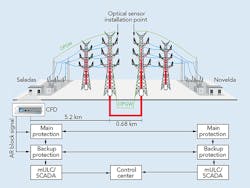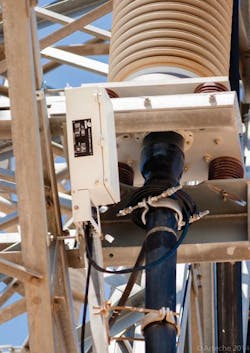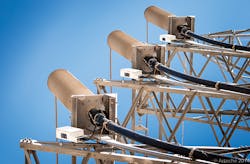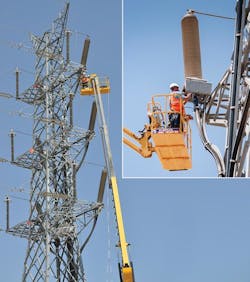The Red Eléctrica de España (REE) high-voltage transmission system includes existing circuits that comprise mainly overhead lines with short sections of underground cable. To comply with environmental and visual amenity considerations, the number of existing and proposed high-voltage transmission lines mixing overhead and underground cable is on the rise.
In the event of a fault on high-voltage transmission lines, auto-reclosing is one of the main protection functions. The majority of the faults on overhead lines are temporary, so auto-reclosing normally will clear the fault and restore the availability of the system. However, faults on underground cables are mainly permanent and an auto-reclosing sequence could potentially worsen the damage.
Therefore, the protection scheme challenge is more demanding with high-voltage mixed lines because they include underground cable sections. It is important to be able to determine if the fault occurred in the underground cable section to block the reclosing function. The most reliable way to achieve this is by implementing a differential protection scheme on the cable section, but this can be costly and oftentimes is not practically feasible.
Selected Technology
As a result of considering the limited technology possibilities commercially available, REE, the Spanish transmission system operator (TSO), sought a technology mature enough for field deployment that could substantially improve fault identification on underground cable sections in existing and future overhead transmission lines.
To address this problem, REE selected technology developed by ARTECHE that consisted of a solution based on passive optical sensors for measuring currents to implement a differential fault detection scheme between both ends of the cable section. All the sensors installed are controlled by a single device, a signal processing and cable fault detection (CFD) unit, located in the closest available substation. The connection of the current sensors to the CFD is made by means of standard single-mode fiber-optic cables.
One of the main targets of the project was to provide CFD functionality without altering the utility’s existing infrastructure and interfering with the protection and control functions already in place. As a result, the system had to be designed to maximize the level of integration and reduce the impact on existing equipment installed on the transmission line.
Proposed Solution
The currents are measured with Faraday-effect passive optical sensors. The fact the current sensors are passive is actually key to the system. They can be installed on the desired measurement point with no need for a power supply, unlike other types of current sensors such as Rogowski coils. This feature, together with the fact the connection between the sensors and the CFD is made using standard fibers, enables the implementation of a remote measurement system, reducing the infrastructure required.
Fiber optics from the existing optical ground wire (OPGW) cable are used for connecting the sensors to the CFD. As fiber optics in the OPGW are a scarce resource, the system has been designed so only two fiber-optic pairs are required for operating the entire system. In addition, to make the installation easier, the splice boxes used to contain the optical circuits and the corresponding fixing elements are those regularly used by the TSO on OPGW installations.
Each optical sensor has a flexible sensing coil embedded on an all-dielectric cable and is designed to be wrapped around the high-voltage cable, beneath the terminal bushing of the overhead line-to-underground cable transition point. The sensing coil must enclose the high-voltage cable as well as the grounding connection of the high-voltage cable’s shield. This shield also is extended through the bushing, so the system can detect faults on both the cable and the bushing, which is a frequent fault position on underground cable circuits.
An additional advantage of the passive remote current measurement system is that it will not be necessary to undertake maintenance or recalibration after commissioning. Also, the system is continuously self-monitoring the optical signal power level on all the fiber-optic links, so any connectivity failure would be reported immediately through the corresponding alarm contact.
With the segregated phase current measurements provided by the six sensors installed, the CFD unit implements a classic differential algorithm. In the event of a fault on the cable or in the terminal bushing, the system detects it and a digital output is activated on the CFD unit as a reclose block command for the protection relays installed for overhead line protection.
To implement the entire system, the following equipment is required:
• Six optical sensors, namely, three per overhead line-to-underground cable transition point
• Two pairs of standard single-mode fibers from the existing OPGW
• One signal processing and fault detection unit.
Factory Acceptance Tests
A laboratory setup was used to perform the factory acceptance testing required by REE to validate the system’s functionality prior to field commissioning. CMC-356 test equipment from OMICRON was used to generate the test currents. Current outputs were combined with current transformers acting as amplifiers to simulate real system faults up to 4000 A as well as single phase through faults up to 6000 A. To simulate the distance parameters of the circuit selected for field trials, two fiber-optic coils — 5.2 km (3.2 miles) and 6.2 km (3.9 miles) in length — were used.
The reclose block’s digital output from the CFD unit was connected back to the CMC-356 as a triggering input to evaluate the results obtained during the simulations. For monitoring purposes, REE requested an additional output interface, consisting of a digital output for issuing the measured current values in the form of sampled values according to the IEC 61850-9-2LE process bus protocol.
Sensor Integration
The solution was developed to meet REE’s research and development (R&D) project requirements for application on a 220-kV transmission line between Saladas and Novelda to validate the protection scheme for CFD in a high-voltage mixed line. There is a distance of 5.88 km (3.65 miles) between the Saladas substation and the far end of the underground cable section, which has a length of 680 m (2231 ft). The current sensors were installed on transitions towers No. 34 and No. 35 on the Saladas–Novelda transmission line, wrapping them around the underground cable just beneath the terminal bushing without having to make any changes on the tower. Once the sensors were installed, the corresponding fiber-optic cables from the sensors were connected to the designated fiber-optic cables in the OPGW splice box.
The CFD unit located in the Saladas substation measures all currents coming from the six sensors installed. Finally, the CFD auto-reclose block signal is connected to the line protection scheme. In the event of an underground cable fault, the line protection detects the fault and the auto-reclose sequence starts. At the same time, the CFD detects the fault and sends a signal to the line protection, stopping the auto-reclose sequence, and also sends a blocking signal to the micro-logical control unit to inform the control center.
Field Installation
The field installation work took three days, and the material and human resources required were as follows:
• Two linemen, with experience on OPGW installation to complete the fiber-optic splicing and install the sensors
• A 40-m (131-ft) tower crane for elevating the linemen to the cable’s terminal bushings
• A standard fiber-optic splicer
• Standard tools for handling fiber optics and undertaking OPGW installations.
It was not necessary to install any active equipment requiring power supply on the measurement points, and the circuit was energized during the installation. Also, it was not necessary to change any settings or make adjustments in the field, or to modify REE’s existing protection and control system.
Although the high-voltage overhead line circuit selected for the field trial only includes one underground cable section, this protection system could be used on high-voltage overhead line circuits with a number of underground cable sections.
To date, the 220-kV circuit has not experienced a cable fault, so the newly installed protection system has not operated. However, to validate the operational performance, REE soon will install an external disturbance recorder, connecting it to the digital output of the CFD unit, which is compatible with the IEC 61850-9-2LE process bus protocol as well as to the conventional protection to provide comparable results when an external cable fault occurs.
Future Optimization
The main objective of the system is to ensure full reliability of the line’s protection scheme. However, it also has been designed under the premise of optimizing the installation equipment required, maximizing the integration of existing infrastructure, drastically minimizing capital expenditure, simplifying the installation process and reducing the commissioning time. Furthermore, the system does not require any operation or maintenance work, which adds to the long-term cost efficiency of the solution. The result of this R&D project is a system that will provide full reliability and maximum integration at minimum cost.
The optical current measurement technology enables the improvement of the electrical network protection capabilities. However, REE identified a challenge that has not yet been addressed, namely, the location of the fault on the underground cable. In fact, this was one of the additional requirements specified that would have allowed REE to have precise information about the failure position on the cable to optimize restoration of the line.
REE’s long-term objection is to replace distance protection with a new technology that can detect underground cable faults. REE is currently testing a similar solution from an alternative vendor that compares with ARTECHE’s technology before establishing a new standard. With the underground cables installed prior to the use of integral fiber optics, there will be a problem retrofitting this form of protection on all existing high-voltage mixed lines.
Acknowledgement
This project was made possible thanks to the R&D project promoted by REE. The author wishes to acknowledge ARTECHE’s support in the development of the technology and in the preparation of this article.
Francisco Javier Martin Herrera ([email protected]) received a BSEE degree from the Universidad Carlos III of Madrid in 2001 and joined Red Eléctrica de España in 2002. He has worked on protection coordination on the Spanish high-voltage power system and currently is involved in protection studies for the INELFE project and the HVDC interconnection between France and Spain. He has participated in CIGRE B5 working groups on shunt reactor protection and is a member of CENELEC CLC/TC8X on the same topic. Additionally, Martin Herrera is an electrical engineering professor at the Universidad Pontificia Comillas – ICAI of Madrid, where he is responsible for electrical protection subjects.
Mentioned in this article:
ARTECHE | www.arteche.com
OMICRON | www.omicron.at
Red Eléctrica de España | www.ree.es






